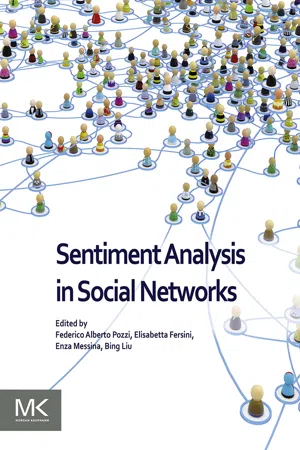
Sentiment Analysis in Social Networks
- 284 pages
- English
- ePUB (mobile friendly)
- Available on iOS & Android
Sentiment Analysis in Social Networks
About This Book
The aim of Sentiment Analysis is to define automatic tools able to extract subjective information from texts in natural language, such as opinions and sentiments, in order to create structured and actionable knowledge to be used by either a decision support system or a decision maker. Sentiment analysis has gained even more value with the advent and growth of social networking.
Sentiment Analysis in Social Networks begins with an overview of the latest research trends in the field. It then discusses the sociological and psychological processes underling social network interactions. The book explores both semantic and machine learning models and methods that address context-dependent and dynamic text in online social networks, showing how social network streams pose numerous challenges due to their large-scale, short, noisy, context- dependent and dynamic nature.
Further, this volume:
- Takes an interdisciplinary approach from a number of computing domains, including natural language processing, machine learning, big data, and statistical methodologies
- Provides insights into opinion spamming, reasoning, and social network analysis
- Shows how to apply sentiment analysis tools for a particular application and domain, and how to get the best results for understanding the consequences
- Serves as a one-stop reference for the state-of-the-art in social media analytics
- Takes an interdisciplinary approach from a number of computing domains, including natural language processing, big data, and statistical methodologies
- Provides insights into opinion spamming, reasoning, and social network mining
- Shows how to apply opinion mining tools for a particular application and domain, and how to get the best results for understanding the consequences
- Serves as a one-stop reference for the state-of-the-art in social media analytics
Frequently asked questions
Information
Challenges of Sentiment Analysis in Social Networks
An Overview
b University of Milano-Bicocca, Milan, Italy
c University of Illinois at Chicago, Chicago, IL, United States
Abstract
Keywords
1 Background


Table of contents
- Cover image
- Title page
- Table of Contents
- Copyright
- Contributors
- Editors’ Biographies
- Preface
- Acknowledgments
- Chapter 1: Challenges of Sentiment Analysis in Social Networks: An Overview
- Chapter 2: Beyond Sentiment: How Social Network Analytics Can Enhance Opinion Mining and Sentiment Analysis
- Chapter 3: Semantic Aspects in Sentiment Analysis
- Chapter 4: Linked Data Models for Sentiment and Emotion Analysis in Social Networks
- Chapter 5: Sentic Computing for Social Network Analysis
- Chapter 6: Sentiment Analysis in Social Networks: A Machine Learning Perspective
- Chapter 7: Irony, Sarcasm, and Sentiment Analysis
- Chapter 8: Suggestion Mining From Opinionated Text
- Chapter 9: Opinion Spam Detection in Social Networks
- Chapter 10: Opinion Leader Detection
- Chapter 11: Opinion Summarization and Visualization
- Chapter 12: Sentiment Analysis With SpagoBI
- Chapter 13: SOMA: The Smart Social Customer Relationship Management Tool: Handling Semantic Variability of Emotion Analysis With Hybrid Technologies
- Chapter 14: The Human Advantage: Leveraging the Power of Predictive Analytics to Strategically Optimize Social Campaigns
- Chapter 15: Price-Sensitive Ripples and Chain Reactions: Tracking the Impact of Corporate Announcements With Real-Time Multidimensional Opinion Streaming
- Chapter 16: Conclusion and Future Directions
- Author Index
- Subject Index